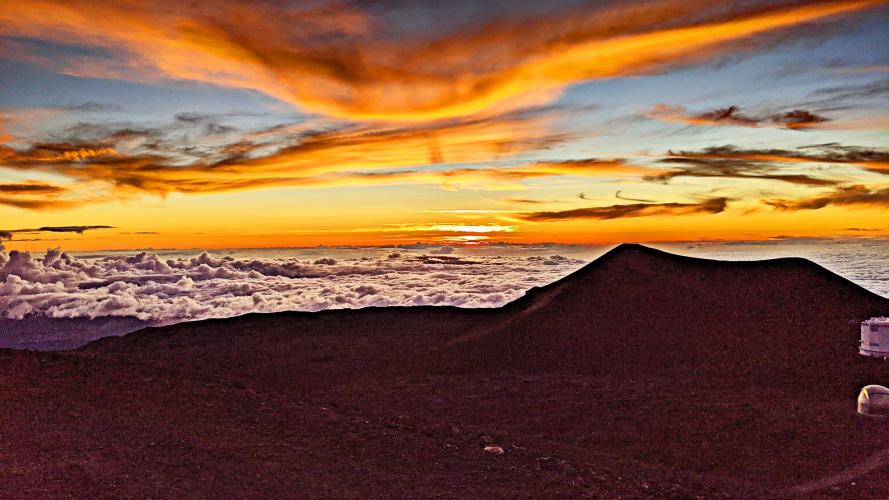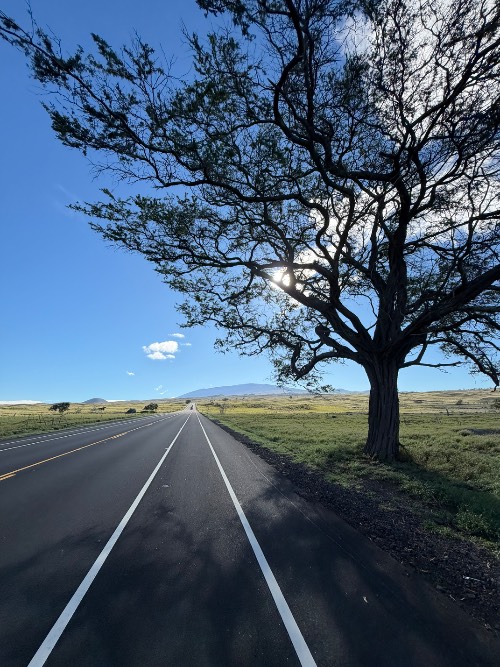![Cycling Mauna Kea from the West Cycling Mauna Kea from the West - panoramic photo of PJAMM Cyclist climbing Mauna Kea, above the clouds]()
Cycling Mauna Kea from the West (Waikoloa and Kona side).
Ride 59.6 miles gaining 14,653’ at 4.4% average grade.
This is the “easier” (ha, ha) approach to Mauna Kea (the other being Mauna Kea from Hilo). We have neutralized this side so MK does not unduly dominate the rankings, but at 21.7 Fiets, Mauna Kea West ranks #7 World, just ahead of Pico de Veleta (20.4) and just behind Alpe Fuori (22.2).
Other than the photo captions, below is a summary from PJAMM friend and contributor Luke Hise of Phoenix, Arizona, USA. See also the excellent summary of Mollie Bernstein’s ascent of this beast - Mollie’s Great Adventure!
![Cycling Mauna Kea from the West Cycling Mauna Kea from the West - group of PJAMM Cyclists standing with bikes at climb start, parrots in tree, beach at the Hilton Waikoloa Village]()
Start at Anaehoomalu Point near the Hilton Waikoloa Village.
Before heading out on your cycling adventure, be sure to rely on our list of Things to Bring on a Cycling Trip, and use our interactive checklist to ensure you don't forget anything.
The ride begins as usual with the ceremonial tire-dipping into the Pacific.
In keeping with custom, and to ensure that one starts from sea level, I began my climb by dipping my bike tires into the Pacific Ocean. With the moon more prominent than the sun, I clipped in at the round-about of the Mauna Kea Beach Collection Autograph Hotel and set forth. As an aside, I can wholeheartedly recommend this establishment for those pursuing a more secluded and quieter hotel experience.
![Cycling Mauna Kea from the West Cycling Mauna Kea from the West - cyclists riding on shoulder of highway before Old Saddle Road, country setting]()
Start to Old Saddle Road
18.9 miles gaining 2,856’’ at 2.6% average grade.
This segment is not for traffic-averse cyclists.
Be sure to have SAG support. If you do not have your own, as of December, 2020, Christian James (also a photographer) can be hired to SAG and photograph your momentous ride. ChristianJamesPhoto@gmail.com and his website address is http://ChristianJamesPhoto.com. Some of the photos on this page are from Christian with his consent.
![Cycling Mauna Kea from the West Cycling Mauna Kea from the West - cyclists riding on Old Saddle Road, straight, two-lane roadway in great condition, country setting]()
Old Saddle Road -- quiet and peaceful.
11.3 miles gaining 3,100’ at 4.8% average grade.
The first 20 miles and 2800 ft of climbing felt tame and manageable. However, as a desert dweller, I was admittedly unprepared for the humidity. By the 30 mile and 4500 foot mark, I had exhausted my 3L Camelbak and was avidly searching for pit stop. The good people at Bike Works Waimea had informed me that the only water resupply to be found en route was located at the Gilbert Kahele Recreation Park. Checking my map, I realized that I would be traveling another 10 miles before water. Feeling desperate, I pulled into the entry way of the Pohakuloa Training Area and petitioned a young man of the US Army for a refill.
![Cycling Mauna Kea from the West Cycling Mauna Kea from the West - road sign points to Pohakuloa Training Center]()
Mile 37.
Seemingly bemused by this soaked/bedraggled tourist, he took pity on me and I had my refill. As I prepared to exit, he offered encouragement, stating something to the effect of "it is only another mile or so of climbing then it is all downhill to Hilo.” I chuckled within, thanked him profusely, and resumed.
![Cycling Mauna Kea from the West Cycling Mauna Kea from the West - stretches of highway from Old Saddle Road to Mauna Kea Access Road]()
End of Old Saddle Road to MK Access Road
13.7 miles at 1.6% average grade (but, there are three descents that make that percentage misleading).
5,430’ to 6,577’.
The next seven miles were of no consequence and presented the only respite since the Ocean. A net downhill of 150 feet, and it was time for a left turn.
![Cycling Mauna Kea from the West Cycling Mauna Kea from the West - visitor center at Mauna Kea Park]()
Mauna Kea Park -- some provisions -- fluids and junk food . . . .
. . . Luke was not aware of this “Oasis” one mile past the military base . . . 😧
![Cycling Mauna Kea from the West Cycling Mauna Kea from the West - straight section of two-lane roadway, grade steepens]()
That’s is were the going starts (and does not stop) to get tough.
6.3 miles gaining 2,586’ at 8.5% average grade.
Beginning MK Access Road at 6,577’ to 9,163’ at the Visitor Center.
The original Mauna Kea climb page details the next 14.7 and 7500 feet well. Their advice regarding energy conservation on the "approach" cannot be overstated. To this point, I had ridden 46 miles and 7165 ft. I was suffering from the 10 miles of running dry, and I promised myself rest at the First Light Visitor Center. The next 6.2 miles to the visitor center announced clearly that this endeavor will not be completed without struggle. 2600 feet later, I emptied several Gatorades and prepared for the "gravel.” This ride is impossible without a support vehicle, unless one is interested in riding a mountain bike from sea level to summit.
![Cycling Mauna Kea from the West Cycling Mauna Kea from the West - First Light Visitor Center, snacks, cyclists sitting on stone retaining wall eating snacks]()
There are some decent (well, in my opinion anyway . . . ) provisions at the VC.
![Cycling Mauna Kea from the West Cycling Mauna Kea from the West - cyclist changing tires at visitor center, swapping road tires to gravel tires]()
Transition to MTB or at least 40mm gravel tires at the Visitor Center.
![Cycling Mauna Kea from the West Cycling Mauna Kea from the West - cyclists ride past sign reading 4x4 only]()
The next 4.7 miles should be done on a mountain bike. I attempted this section on a 40 mm gravel bike, but again, the "gravel" was in fact, a fine layer of silt/volcanic debris that felt akin to sand at times. This section was preposterous. Superlatives are inadequate to describe the effort. I would wager I walked at least 1/5 of this segment. With the benefit of hindsight, I will return with a hardtail mountain bike running a dinner plate sized cassette and 30 psi.
![Cycling Mauna Kea from the West Cycling Mauna Kea from the West - cyclists ride on gravel section of roadway, sign reads "Mauna Kea Ice Age Natural Area Preserve"]()
Gravel section.
4.7 miles gaining 2,408’ at 11.1% average grade.
Elevation 9,348 to 11,756’.
![Cycling Mauna Kea from the West Cycling Mauna Kea from the West - PJAMM Cyclist riding on paved portion of volcanic roadway]()
After 4.7 miles of hell, we return to pavement, but . . .
![Cycling Mauna Kea from the West Cycling Mauna Kea from the West - photo collage, cyclists riding toward climb finish, elevation signs read 13000 feet]()
Gravel to Top.
3.7 miles gaining 2,020’ at 9.3% average grade at 12,000-13,700’.
This segment has the steepest grades on the climb with a full ½ mile at 16.5%.
I returned to the pavement, and my trusty SAG was waiting with my roadie. I was exhausted. Spent. The excitement of departing the dirt evaporated immediately as I begun to cramp not 400m back on the road. My ability to continue was absolutely in jeopardy. I wished for a bigger cassette and a lighter bike. I had jettisoned everything in the SAG, helmet and pack included. I kept only my shirt, as the forewarned colder climes became manifest. Slowing to a serpentine crawl, the 3.7 miles took me just under an hour.
![Cycling Mauna Kea from the West Cycling Mauna Kea from the West - cyclist climbs on roadway toward climb finish, Observation Center can be seen in distance, sign warning to use low gear]()
Approaching the finish.
![Cycling Mauna Kea from the West Cycling Mauna Kea from the West - PJAMM Cyclists at climb finish, observation center behind them]()
Upper left: Charlie Thackeray (UK) 7-6-19
Upper right: Luke Hise (USA) 11-3-20
I have been fortunate to ride in a variety of locales. I am slowly chipping away at the PJAMM's "Most Spectacular" and "Top 100" climbs. I have had the luxury of riding in France, Italy, and many areas of the American Rockies. What awaited me at the summit of this ride was an otherworldly experience. All other adventures now paled in comparison. The difficulty and the grandeur of Mauna Kea reset the bar for both challenge and scenery. I lingered for an hour at the top. The sunset will remain ensconced in my memory. Pictures fail to do it justice.
Do this ride.
![Cycling Mauna Kea from the West Cycling Mauna Kea from the West - sunset atop Mauna Kea]()
That’s a wrap!!
![]()
Thank you Daniel McAuley and Mollie Bernstein!!
RESPECT MAUNA KEA: A SACRED MOUNTAIN
Not only is Mauna Kea the highest point in all the Hawaiian Islands, it is a sacred mountain to native Hawaiians and the center of their ancestral ties to creation.
From Jeremiah Bishop (The Impossible Route / Climb Page) And remember "respect Mauna Kea" This should go on your page for the climbs there. It is a sacred place for the native peoples there but it should be also for us as visitors. In fact the largest physical prominence on earth at nearly 34,000 ft makes you think how thin this habitably range is for humans or terrestrial creatures. The planet looks small from up there and that's because it is.

 We've partnered with Sherpa-Map.com to bring you the best route planning tool. With a PRO Membership you can use this climb as a reference when creating your route.
We've partnered with Sherpa-Map.com to bring you the best route planning tool. With a PRO Membership you can use this climb as a reference when creating your route. 


